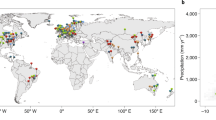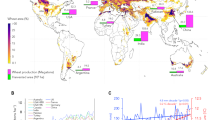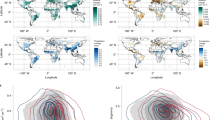Abstract
Rising atmospheric CO2 concentrations ([CO2]) are expected to enhance photosynthesis and reduce crop water use1. However, there is high uncertainty about the global implications of these effects for future crop production and agricultural water requirements under climate change. Here we combine results from networks of field experiments1,2 and global crop models3 to present a spatially explicit global perspective on crop water productivity (CWP, the ratio of crop yield to evapotranspiration) for wheat, maize, rice and soybean under elevated [CO2] and associated climate change projected for a high-end greenhouse gas emissions scenario. We find CO2 effects increase global CWP by 10[0;47]%–27[7;37]% (median[interquartile range] across the model ensemble) by the 2080s depending on crop types, with particularly large increases in arid regions (by up to 48[25;56]% for rainfed wheat). If realized in the fields, the effects of elevated [CO2] could considerably mitigate global yield losses whilst reducing agricultural consumptive water use (4–17%). We identify regional disparities driven by differences in growing conditions across agro-ecosystems that could have implications for increasing food production without compromising water security. Finally, our results demonstrate the need to expand field experiments and encourage greater consistency in modelling the effects of rising [CO2] across crop and hydrological modelling communities.
This is a preview of subscription content, access via your institution
Access options
Subscribe to this journal
Receive 12 print issues and online access
$209.00 per year
only $17.42 per issue
Buy this article
- Purchase on Springer Link
- Instant access to full article PDF
Prices may be subject to local taxes which are calculated during checkout




Similar content being viewed by others
References
Kimball, B. A. in Handbook of Climate Change and Agroecosystems, Impacts, Adaptation, and Mitigation Vol. 1 (eds Hillel, D. & Rosenzweig, C.) 87–107 (Imperial College, 2011).
Vanuytrecht, E., Raes, D., Willems, P. & Geerts, S. Quantifying field-scale effects of elevated carbon dioxide concentration on crops. Clim. Res. 54, 35–47 (2012).
Rosenzweig, C. et al. Assessing agricultural risks of climate change in the 21st century in a global gridded crop model intercomparison. Proc. Natl Acad. Sci. USA 111, 3268–3273 (2014).
Vörösmarty, C. J. et al. Global threats to human water security and river biodiversity. Nature 467, 555–561 (2010).
Schewe, J. et al. Multimodel assessment of water scarcity under climate change. Proc. Natl Acad. Sci. USA 111, 3245–3250 (2014).
Wheeler, T. R. & von Braun, J. Climate change impacts on global food security. Science 341, 508–513 (2013).
Elliott, J. et al. Constraints and potentials of future irrigation water availability on agricultural production under climate change. Proc. Natl Acad. Sci. USA 111, 3239–3244 (2014).
Hanjra, M. A. & Qureshi, M. E. Global water crisis and future food security in an era of climate change. Food Policy 35, 365–377 (2010).
Rockström, J. & Falkenmark, M. Semiarid crop production from a hydrological perspective: gap between potential and actual yields. Crit. Rev. Plant Sci. 19, 319–346 (2000).
Brauman, K. A., Siebert, S. & Foley, J. A. Improvements in crop water productivity increase water sustainability and food security—a global analysis. Environ. Res. Lett. 8, 024030 (2013).
Burkart, S., Manderscheid, R., Wittich, K. P., Löpmeier, F. J. & Weigel, H. J. Elevated CO2 effects on canopy and soil water flux parameters measured using a large chamber in crops grown with free-air CO2 enrichment. Plant Biol. 13, 258–269 (2011).
Long, S. P., Ainsworth, E. A., Leakey, A. D. B., Nösbsrger, J. & Ort, D. R. Food for thought: lower-than-expected crop yield stimulation with rising CO2 concentrations. Science 312, 1918–1921 (2006).
Tubiello, F. N. et al. Crop response to elevated CO2 and world food supply: a comment on “Food for Thought...” by Long et al., Science 312: 1918–1921, 2006. Eur. J. Agron. 26, 215–223 (2007).
Ainsworth, E. A., Leakey, A. D. B., Ort, D. R. & Long, S. P. FACE-ing the facts: inconsistencies and interdependence among field, chamber and modeling studies of elevated [CO2] impacts on crop yield and food supply. New Phytol. 179, 5–9 (2008).
Leakey, A. D. B. et al. Elevated CO2 effects on plant carbon, nitrogen, and water relations: six important lessons from FACE. J. Exp. Bot. 60, 2859–2876 (2009).
Leakey, A. D. B., Bishop, K. A. & Ainsworth, E. A. A multi-biome gap in understanding of crop and ecosystem responses to elevated CO2 . Curr. Opin. Plant Biol. 15, 228–236 (2012).
Rosenthal, D. M. & Tomeo, N. J. Climate, crops and lacking data underlie regional disparities in the CO2 fertilization effect. Environ. Res. Lett. 8, 031001 (2013).
Boote, K. J., Jones, J. W., White, J. W., Asseng, S. & Lizaso, J. I. Putting mechanisms into crop production models. Plant Cell Environ. 36, 1658–1672 (2013).
Liu, J. A GIS-based tool for modelling large-scale crop-water relations. Environ. Modell. Softw. 24, 411–422 (2009).
Fader, M., Rost, S., Müller, C., Bondeau, A. & Gerten, D. Virtual water content of temperate cereals and maize: present and potential future patterns. J. Hydrol. 384, 218–231 (2010).
Porter, J. R. et al. in Climate Change 2014: Impacts, Adaptation, and Vulnerability (eds Field, C. B. et al.) Ch. 7, 485–533 (IPCC, Cambridge Univ. Press, 2014).
Asseng, S. et al. Uncertainty in simulating wheat yields under climate change. Nature Clim. Change 3, 827–832 (2013).
Hempel, S., Frieler, K., Warszawski, L., Schewe, J. & Piontek, F. A trend-preserving bias correction—the ISI-MIP approach. Earth Syst. Dyn. Discuss. 4, 49–92 (2013).
Moss, R. H. et al. The next generation of scenarios for climate change research and assessment. Nature 463, 747–756 (2010).
Portmann, F. T., Siebert, S. & Döll, P. MIRCA2000—Global monthly irrigated and rainfed crop areas around the year 2000: a new high-resolution data set for agricultural and hydrological modeling. Glob. Biogeochem. 24, 024023 (2010).
Rockström, J. et al. Managing water in rainfed agriculture—The need for a paradigm shift. Agric. Water Manage. 97, 543–550 (2010).
Rost, S. et al. Global potential to increase crop production through water management in rainfed agriculture. Environ. Res. Lett. 4, 044002 (2009).
Gassman, P. W. et al. Historical Development and Applications of the EPIC and APEX Models Working Paper 05-WP 397 (2005); http://www.card.iastate.edu/publications/dbs/pdffiles/05wp397.pdf
Izaurralde, R. C., Williams, J. R., McGill, W. B., Rosenberg, N. J. & Jakas, M. C. Q. Simulating soil C dynamics with EPIC: model description and testing against long-term data. Ecol. Model. 192, 362–384 (2006).
Williams, J. R. EPIC-Erosion/Productivity Impact Calculator Technical Bulletin Number 1768 (USDA Agricultural Research Service, 1990).
Williams, J. R. in Computer Models of Watershed Hydrology (ed. Singh, V. P.) Ch. 25, 909–1000 (Water Resources, 1995).
Liu, J., Williams, J. R., Zehnder, A. & Yang, H. GEPIC—modelling wheat yield and crop water productivity with high resolution on a global scale. Agric. Syst. 94, 478–493 (2007).
Bondeau, A. et al. Modelling the role of agriculture in the 20th century global terrestrial carbon balance. Glob. Change Biol. 13, 679–706 (2007).
Waha, K., van Bussel, L. G. J., Müller, C. & Bondeau, A. Climate-driven simulation of global crop sowing dates. Glob. Ecol. Biogeogr. 21, 247–259 (2011).
Lindeskog, M. et al. Implications of accounting for land use in simulations of ecosystem services and carbon cycling in Africa. Earth Syst. Dyn. Discuss. 4, 235–278 (2013).
Smith, B., Prentice, I. C. & Sykes, M. T. Representation of vegetation dynamics in the modelling of terrestrial ecosystems: comparing two contrasting approaches within European climate space. Glob. Ecol. Biogeogr. 10, 621–637 (2001).
Elliott, J. et al. The parallel system for integrating impact models and sectors (pSIMS). Environ. Modell. Softw. 62, 509–516 (2014).
Jones, J. W. et al. The DSSAT cropping system model. Eur. J. Agron. 18, 235–265 (2003).
Deryng, D., Conway, D., Ramankutty, N., Price, J. & Warren, R. Global crop yield response to extreme heat stress under multiple climate change futures. Environ. Res. Lett. 9, 034011 (2014).
Deryng, D., Sacks, W. J., Barford, C. C. & Ramankutty, N. Simulating the effects of climate and agricultural management practices on global crop yield. Glob. Biogeochem. Cycles 25, 1–18 (2011).
Farquhar, G. D., Caemmerer, S. & Berry, J. A. A biochemical model of photosynthetic CO2 assimilation in leaves of C3 species. Planta 149, 78–90 (1980).
Sitch, S. et al. Evaluation of ecosystem dynamics, plant geography and terrestrial carbon cycling inthe LPJ dynamic global vegetation model. Glob. Change Biol. 9, 161–185 (2003).
Penman, H. L. Natural evaporation from open water, bare soil, and grass. Proc. R. Soc. Lond. A 193, 120–145 (1948).
Monteith, J. Evaporation and environment. Symp. Soc. Exp. Biol. 19, 205–224 (1965).
Priestley, C. H. B. & Taylor, R. J. On the assessment of surface heat flux and evaporation using large-scale parameters. Mon. Weath. Rev. 100, 81–92 (1972).
Neitsch, S. L., Arnold, J. G., Kiniry, J. R. & Williams, J. R. Soil and Water Assessment Tool. Theoretical Documentation, Version 2005 (Grassland, Soil and Water Research Laboratory, Agricultural Research Service, 2005).
Stockle, C. O., Williams, J. R., Rosenberg, N. J. & Jones, C. A. A method for estimating the direct and climatic effects of rising atmospheric carbon dioxide on growth and yield of crops: Part 1–modification of the epic model for climate change analysis. Agric. Syst. 38, 225–238 (1992).
Boote, K. J., Allen, L. H. Jr, Prasad, P. V. V. & Jones, J. W. in Handbook of Climate Change and Agroecosystems—Impacts, Adaptation, and Mitigation Vol. 1 (eds Hillel, D. & Rosenzweig, C.) Ch. 6 (Imperial College, 2011).
Farquhar, G. & von Caemmerer, S. in Encyclopedia of Plant Physiology. New Series Vol. 12B (ed. Lange, O.) 549–587 (Springer, 1982).
Boote, K. J. & Pickering, N. B. Modeling photosynthesis of row crop canopies. HortScience 29, 1423–1434 (1994).
Pickering, N. B., Jones, J. W. & Boote, K. J. in Climate Change and Agriculture: Analysis of Potential International Impacts (eds Rosenzweig, C., Jones, J. W. & Allen, L. H. J.) 147–162 (American Society of Agronomy, 1995).
Gerten, D., Schaphoff, S. & Lucht, W. Potential future changes in water limitations of the terrestrial biosphere. Climatic Change 80, 277–299 (2007).
Peel, M. C., Finlayson, B. L. & McMahon, T. A. Updated world map of the Köppen-Geiger climate classification. Hydrol. Earth Syst. Sci. 4, 439–473 (2007).
Hunsaker, D. J., Kimball, B. A., Pinter, P. J., LaMorte, R. L. & Wall, G. W. Carbon dioxide enrichment and irrigation effects on wheat evapotranspiration and water use efficiency. Trans. ASAE 39, 1345–1355 (1996).
Hunsaker, D. J. et al. CO2 enrichment and soil nitrogen effects on wheat evapotranspiration and water use efficiency. Agric. For. Meteorol. 104, 85–105 (2000).
Kimball, B. A., Kobayashi, K. & Bindi, M. Responses of Agricultural Crops to Free-Air CO2 Enrichment 77, 293–368 (2002).
Kimball, B. A. et al. Free-air CO2 enrichment and soil nitrogen effects on energy balance and evapotranspiration of wheat. Wat. Resour. Res. 35, 1179–1190 (1999).
Weigel, H.-J. & Manderscheid, R. Crop growth responses to free air CO2 enrichment and nitrogen fertilization: rotating barley, ryegrass, sugar beet and wheat. Eur. J. Agron. 43, 97–107 (2012).
O’Leary, G. et al. Response of wheat growth, grain yield and water use to elevated CO2 under a Free-Air CO2 Enrichment (FACE) experiment and modelling in a semi-arid environment. Glob. Change Biol. 21, 2670–2686 (2015).
Zhu, C., Xu, X., Wang, D., Zhu, J. & Liu, G. An indica rice genotype showed a similar yield enhancement to that of hybrid rice under free air carbon dioxide enrichment. Sci. Rep. 5, 12719 (2015).
Shimono, H., Nakamura, H., Hasegawa, T. & Okada, M. Lower responsiveness of canopy evapotranspiration rate than of leaf stomatal conductance to open-air CO2 elevation in rice. Glob. Change Biol. 19, 2444–2453 (2013).
Bernacchi, C. J., Kimball, B. A., Quarles, D. R., Long, S. P. & Ort, D. R. Decreases in stomatal conductance of soybean under open-air elevation of [CO2] are closely coupled with decreases in ecosystem evapotranspiration. Plant Physiol. 143, 134–144 (2006).
Manderscheid, R., Erbs, M. & Weigel, H.-J. Interactive effects of free-air CO2 enrichment and drought stress on maize growth. Eur. J. Agron. 52, 11–21 (2014).
Acknowledgements
This work has been conducted under the framework of ISI-MIP and in partnership with the AgMIP community. The ISI-MIP Fast Track project was funded by the German Federal Ministry of Education and Research (BMBF) with project funding reference number 01LS1201A. We acknowledge the World Climate Research Programme’s Working Group on Coupled Modelling, which is responsible for CMIP, and we thank the climate modelling groups for producing and making available their model output. For CMIP the US Department of Energy’s Program for Climate Model Diagnosis and Intercomparison provides coordinating support and led development of software infrastructure in partnership with the Global Organization for Earth System Science Portals. This work was also supported by a research stipend from the Tyndall Centre for Climate Change Research and a Belmont Forum grant from the UK Natural Environment Research Council (grant no. NE/L008785/1) to D.D., by the National Science Foundation under grants SBE-0951576 and GEO-1215910 to J.E., by the BMBF grant 01LN1317A to C.M., and by the Formas Strong Research Environment ‘land use today and tomorrow’ to S.O., T.A.M.P. was supported by EU FP7 project EMBRACE (grant no. 282672). We are grateful to B. A. Kimball and A. Leakey for pointing out appropriate literature on the FACE experiments.
Author information
Authors and Affiliations
Contributions
D.D. had the main responsibility for the study idea, methods, analysis and writing the paper. D.D., J.E. and C.R. designed and coordinated the modelling intercomparison analysis. J.E., C.F., C.M. and T.A.M.P. contributed to analysis. D.D., J.E., C.F., C.M., T.A.M.P., S.O., N.K. and E.S. performed the crop model simulations. J.E., C.M., C.F., T.A.M.P., K.J.B., D.C. and A.C.R. made significant contributions in developing the paper structure and interpreting the results. J.E., A.C.R., D.G., S.S., H.Y., J.W.J. and C.R. made important contributions in developing the original study idea. All authors contributed to writing the paper.
Corresponding author
Ethics declarations
Competing interests
The authors declare no competing financial interests.
Supplementary information
Supplementary Information
Supplementary Information (PDF 6310 kb)
Rights and permissions
About this article
Cite this article
Deryng, D., Elliott, J., Folberth, C. et al. Regional disparities in the beneficial effects of rising CO2 concentrations on crop water productivity. Nature Clim Change 6, 786–790 (2016). https://doi.org/10.1038/nclimate2995
Received:
Accepted:
Published:
Issue Date:
DOI: https://doi.org/10.1038/nclimate2995
This article is cited by
-
Changes in per capita wheat production in China in the context of climate change and population growth
Food Security (2023)
-
Spatiotemporal variation in irrigation water requirements in the China–Pakistan Economic Corridor
Scientific Reports (2022)
-
Six decades of warming and drought in the world’s top wheat-producing countries offset the benefits of rising CO2 to yield
Scientific Reports (2022)
-
Stronger temperature–moisture couplings exacerbate the impact of climate warming on global crop yields
Nature Food (2021)
-
Future rice farming threatened by drought in the Lower Mekong Basin
Scientific Reports (2021)



